An excellent customer experience is the key to any company’s success. It contributes to the firm’s customer loyalty, brand advocacy, and sustained growth.
And this is just as true to enterprise customers as it’s to individuals.
Enterprise customer experience involves all the interactions your business clients have with your organization. It’s a holistic view of your organization from your business client’s various employees, managers, partners, etc.
In this article, we’ll go over what enterprise customer experience is and offer eight actionable tips on how to improve your enterprise customer experience. We’ll also highlight the top five enterprise customer experience software available today to help you get started right away.
This article covers:
(Click on a link below to jump to a specific section)
- What is Enterprise Customer Experience?
- 8 Handy Tips to Improve Enterprise Customer Experience
- Use Specific Tools to Understand the Customer
- Personalize Your Service Offering
- Form an Emotional Bond with Customers
- Deal with Support Requests Effectively
- Be Patient When Approaching a Potential Customer
- Identify Causes of Customer Churn
- Form a Dedicated Customer Experience (CX) Team or Customer Experience Program
- Use a Customer Success Platform
- Top 5 Enterprise Customer Experience Software
Let’s get started.
What is enterprise customer experience?
Enterprise customer experience refers to how a business interacts with its enterprise customers at every point in the customer journey.
In an enterprise customer experience setting, you help enterprises increase productivity and innovation by delivering an overall positive customer experience.
A positive customer experience can help you win customer trust and increase their loyalty, which leads to increased sales. On the other hand, a poor enterprise experience can quickly make customers run to competitors, which you definitely want to avoid.
But how do you always make sure to remain ahead of the competition?
By implementing a solid customer experience strategy.
Let’s find out how you can do that.
8 handy tips to improve enterprise customer experience
It’s essential to focus on providing a positive customer experience for your enterprise customers to reduce customer churn, improve loyalty and customer retention rates.
Let’s look at eight ways you can improve the customer experience for your enterprise clients:
1. Use specific tools to understand the customer
The first step in improving your enterprise customer experience is to understand everything about your customer. This includes their needs, goals, processes, etc.
Only then can you deliver the best possible customer experience.
But how do you understand the customer?
You will need to gather, track, and analyze customer data diligently.
You should also understand what customer needs your company is successfully meeting, those needs that remain unmet, and your customers’ most significant concerns.
Additionally, you need to tailor your company’s onboarding process for your enterprise customers with their workflows and processes in mind.
By figuring out customer expectations and goals, you can effectively meet their needs.
2. Personalize your service offering
Remember that every enterprise has different preferences and needs based on its profile, management, and business type.
Personalization may be a straightforward process for individual consumers, but it can be more complicated at the enterprise level.
Why?
You’ll have to be proactive in your approach to remove unnecessary features, processes, etc., from your offering and make interactions with your client smoother.
You should also be willing to make relevant, reasonable changes or additions to your offerings to best suit the customer’s needs. This is a surefire way to boost the customer’s experience.
3. Form an emotional bond with customers
By connecting emotionally with representatives of your enterprise customer, you can forge a long-term bond with them. This helps with long-term customer retention and can also help you get positive referrals.
Building an emotional bond with your customers starts with a brand identity that perfectly resonates with your clientele. To do this, you need to anticipate the values that will resonate with them.
For example, if your client is a SaaS or eCommerce company, they probably value innovation as these industries are constantly evolving. Your company should portray this in your interactions.
4. Deal with support requests effectively
Did you know you can actually improve customer support requests while saving on operational costs?
All you need is an internal enterprise help desk.
A help desk is an all-in-one platform to unify support and self-service functions across numerous channels.
Such platforms sync all your systems and channels into a single dashboard. This means that your employees have complete access to customer context from a single view.
A help desk platform can help your company manage complex workflows with powerful features like ticket management systems, issue trackers, customer analytics, and more.
For example, to deal with repeated queries, the help desk platform can help you pull in templated answers from the database to provide a quick response.
5. Be patient when approaching a potential customer
A positive customer experience starts from the moment the potential customer begins engaging with your brand. That’s why you need to maintain a positive image even when you’re advertising or pitching to a client.
Moreover, selling your services or product to a large enterprise requires a different approach than selling to individuals.
If you want to sell a product or service, it’s essential to first gain your potential customer’s trust in your brand — usually, this develops over time. For this reason, you need to be patient and consistent with your approaches.
6. Identify causes of customer churn
Customer churn, also known as customer turnover, is the loss of clients or customers during a certain time frame.
When customers churn, you must find its reason and use the information to improve your business operations. And by asking your customers for feedback, you can examine the data and take the right steps to improve on your weak points.
Identifying the cause of a high customer turnover allows you to adjust your service offering before other clients’ become dissatisfied.
Since even a slight increase in customer retention can increase your profits drastically, you need to identify the problem areas as soon as possible.
According to a survey conducted by Retailer, companies with the strongest omnichannel strategies have a retention rate of 89%. So, if all your communication channels are connected seamlessly, you can solve numerous problems in the customer journey.
7. Create a dedicated customer experience (CX) team or customer experience program
Companies with a dedicated customer experience team are more likely to have satisfied customers. A dedicated customer experience team can help align operations according to customer needs by operating cross-functionally with the customer service team.
It’s also important that your team follows a systematic CX program. A CX program is a systematic approach to improving the way your business interacts with its customers.
But what if you don’t have the resources to form a whole new team?
No problem.
You don’t necessarily have to carve out a whole new team to improve your company’s customer experience ecosystem. The most important thing is to plan and define the systems, processes, and touchpoints that will determine the customer journey.
Then, you need to ensure your team members understand and follow these processes properly.
8. Use a customer success platform
It’s critical to give your enterprise customers the positive experience they are looking for to make them happy and satisfied. You can do this by leveraging a customer success platform.
A customer success platform (also known as a customer data platform) lets everyone within the team access information about a customer’s status at any given time.
Pro tip: It’s easier to implement the tips we discussed above with the help of a customer success platform.
For example, sales professionals can use the platform to check how their customers are doing — from their onboarding status to health scores. This way, they know what the customers’ needs are and how to address them immediately.
Additionally, your team gains visibility, responsiveness, and control over the whole enterprise customer management.
In short, having a great customer experience at every touchpoint will deepen customer trust and lead to long-term relationships.
Next, we’ll explore some top-notch enterprise experience software that can help your team improve customer experience with ease.
Top 5 enterprise customer experience software
Here’re our picks for the best enterprise customer experience software on the market:
1. Zendesk
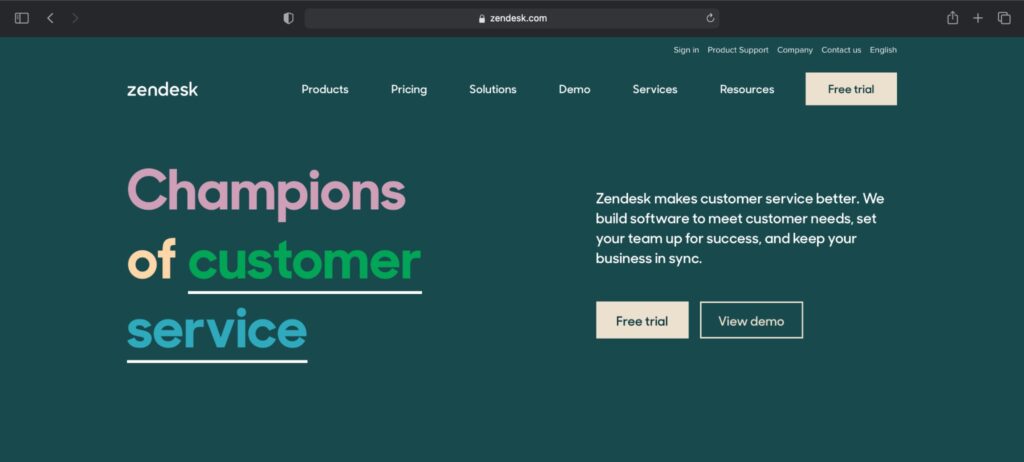
Zendesk helps you create a self-help center for your customers and solve problems faster with its smart ticketing system. It’s a great tool to help you provide a better customer experience.
Multiple integrations and customization options make Zendesk one of the industry favorites.
Key features
- Handle customer support operations by offering support via email, mobile, and live chat with Zendesk Support. It also provides social media support for LinkedIn, Twitter, and more.
- Access customer and business analytics to boost customer experience with its Zendesk Explore feature.
- Provide call center support to your customers with its Zendesk Talk feature.
Pricing
Zendesk’s paid plans start at $49/user per month (billed annually). There’s also a free trial available.
Customer ratings
- G2: 4.3/5 (3100+ reviews)
- Capterra: 4.4/5 (2600+ reviews)
2. IBM Tealeaf
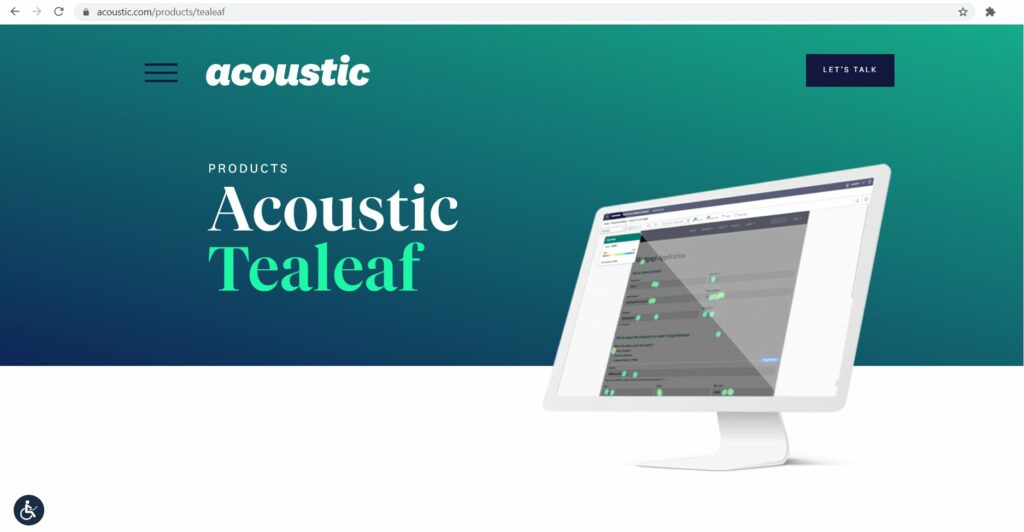
IBM Tealeaf, also known as Acoustic Tealeaf or Acoustic Experience Analytics, is a SaaS-based analytics solution and a cloud service provider.
It provides many ready-to-use reports and customizable dashboards to help you dive deep into your company’s customer experience.
Key features
- Analyze and optimize customer’s experience with Tealeaf’s robust analytics.
- Create highly customized events to record the data you need and segment user sessions with its Event Management feature.
- Access session replays on browsers that show page-by-page customer interaction on your site.
Pricing
IBM Tealeaf provides a customizable pricing plan as per your organization’s needs.
Customer ratings
- G2: 4.1/5 (30+ reviews)
- Capterra: NA
3. HubSpot
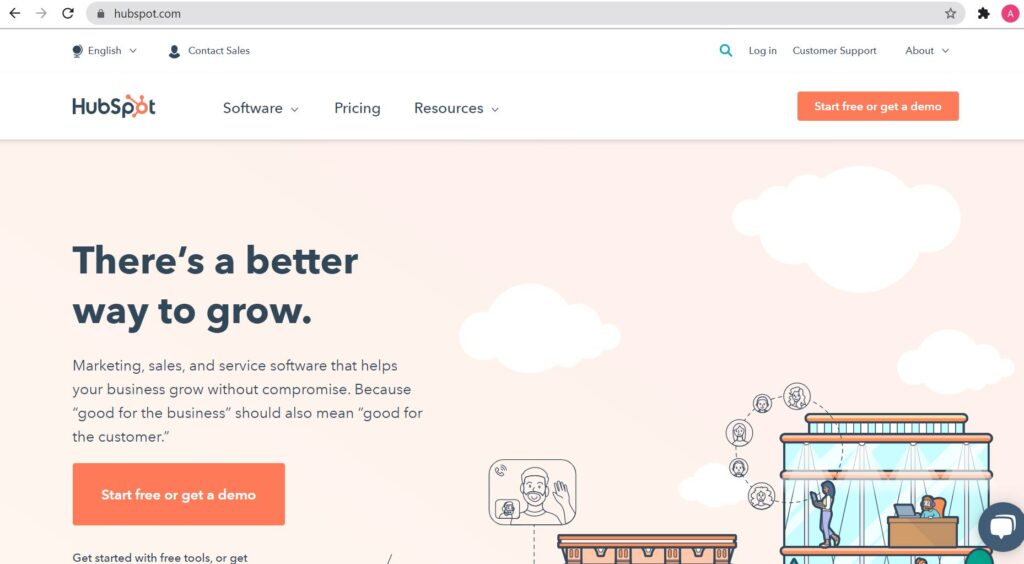
HubSpot offers a comprehensive platform for sales, digital marketing, customer service, and CRM (customer relationship management). The cloud-based CRM tool is designed to help align marketers and sales teams and optimize their inbound marketing strategy.
Key features
- Attract potential customers with social media, blog posts, and ads.
- Make data-backed customer experience decisions with custom reporting and built-in analytics.
- Track ROI (Return on Investment) with its revenue attribution reporting feature.
Pricing
HubSpot has a free plan with limited features, and its paid plans start at $45/user per month.
Customer ratings
- G2: 4.5/5 (1000+ reviews)
- Capterra: 4.5/5 (2800+ reviews)
4. Clarabridge
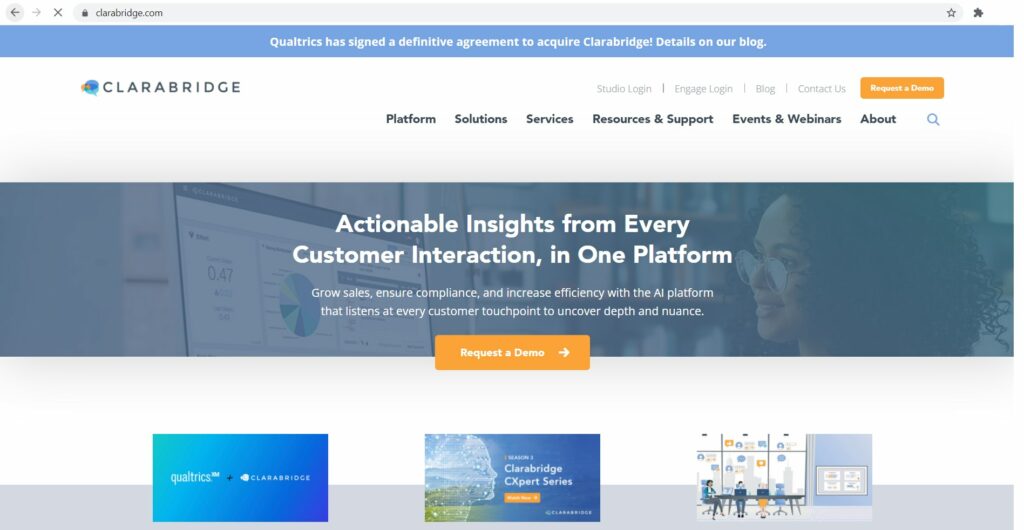
Clarabridge is a cloud-based customer experience management software.
This tool’s functionality helps transform your customer’s feedback into actionable insights so that you can play and deploy performance-enhancing strategies.
Key features
- Create and support an infinite number of reports sourced from multiple projects with Clarabridge’s CX studio.
- Listen to, monitor, and analyze all client interactions with your employees to ensure customer satisfaction at every level.
- Integrates with several third-party solutions like SurveyMonkey, Salesforce, Lithium, Sprinklr, and Trustpilot.
Pricing
Contact the sales team for pricing information.
Customer ratings
- G2: 4.2/5 (170 reviews)
- Capterra: NA
5. Satmetrix
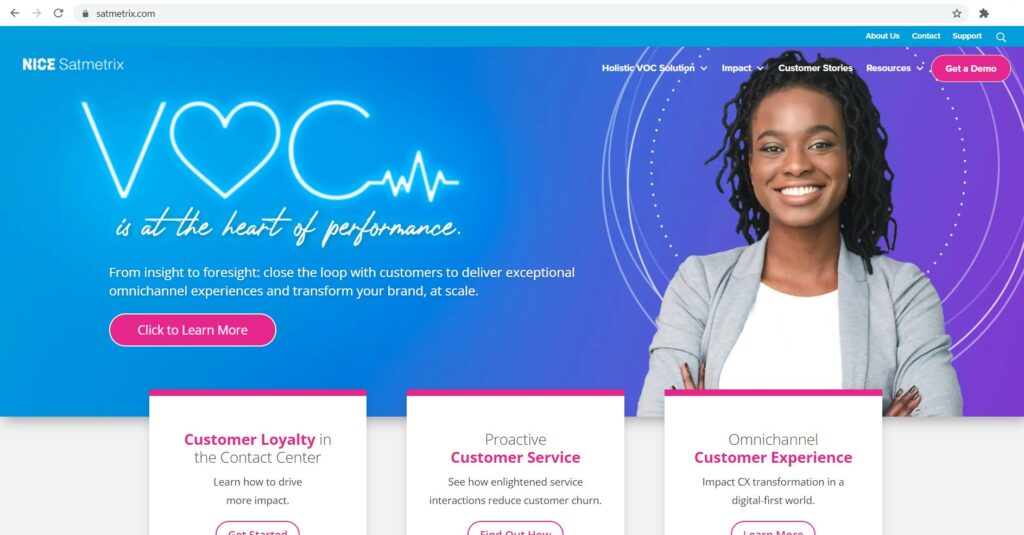
Satmetrix is a customer experience management platform designed to create and manage customer journeys.
It offers you a comprehensive omnichannel experience with one complete and unified platform.
Key features
- Analyze customer feedback from different touchpoints of a customer’s journey, from online to contact center interactions.
- Optimize customer experiences with artificial intelligence (AI) based analytics.
- Empower your employees by helping them solve real-time issues with workflow automation.
Pricing
Contact Satmetrix for pricing information.
Customer ratings
- G2: 4.2/5 (30+ reviews)
- Capterra: NA
Wrapping up
Enterprise customer experience has significant long-term financial implications for any company. That’s why it’s worth perfecting your approach sooner rather than later.
From optimizing the UX (User Experience) on your website to ensuring great post-purchase customer service, customer experience is the investment that pays off in the long run.
Start by using the tips and tools we’ve highlighted here, and then make sure that your business always puts customer needs first. This way, you’ll be able to improve your enterprise customer experience in no time.

Andy is a technology & marketing leader who has delivered award-winning and world-first experiences.


